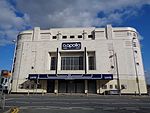Ardwick

Ardwick is a district of Manchester in North West England, one mile south east of the city centre. The population of the Ardwick Ward at the 2011 census was 19,250.Historically in Lancashire, by the mid-nineteenth century Ardwick had grown from being a village into a pleasant and wealthy suburb of Manchester, but by the end of that century it had become heavily industrialised. When its industries later fell into decline then so did Ardwick itself, becoming one of the city's most deprived areas. Substantial development has taken place more recently in Ardwick and other areas of Manchester to reverse the decline, notably the construction of many facilities for the 2002 Commonwealth Games held nearby at the City of Manchester Stadium. In the late nineteenth century Ardwick had many places of entertainment, but the only remnant of that history today is the Art Deco-style Manchester Apollo, a venue for pop and rock music concerts.
Excerpt from the Wikipedia article Ardwick (License: CC BY-SA 3.0, Authors, Images).Ardwick
Hyde Road, Manchester Ardwick
Geographical coordinates (GPS) Address Nearby Places Show on map
Geographical coordinates (GPS)
| Latitude | Longitude |
|---|---|
| N 53.469167 ° | E -2.218611 ° |
Address
Hyde Road
Hyde Road
M12 6BH Manchester, Ardwick
England, United Kingdom
Open on Google Maps









